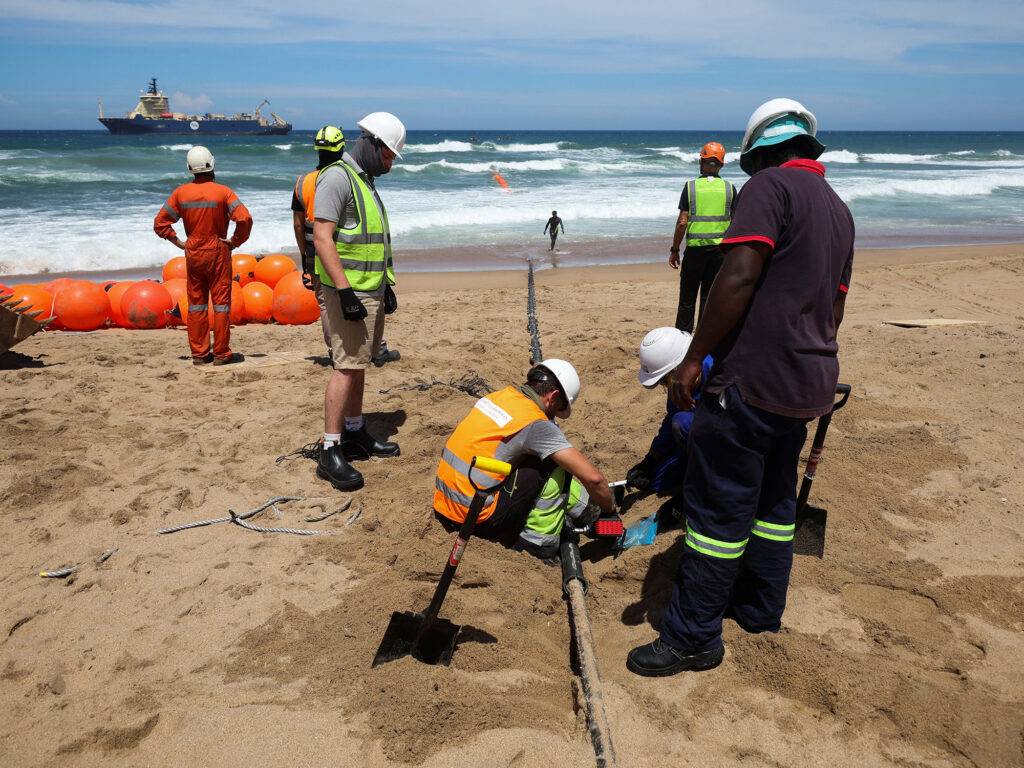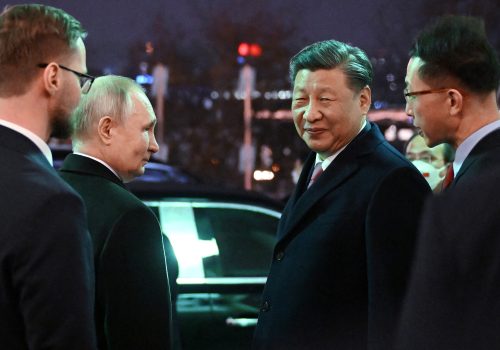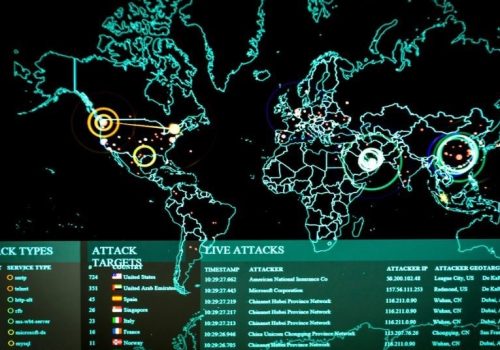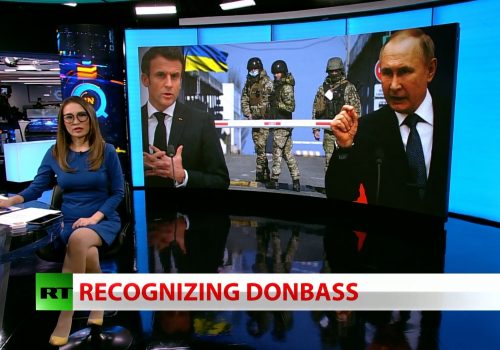Undersea cables are important tools for transmitting sensitive data and supporting international telecommunications—but they’re relatively vulnerable. Sensitive data remains safe as long as undersea cables are in good physical condition, but events such as severe sabotage—in the form of cutting cables—could leak data and interrupt vital international communications. Today, when events that damage or cut a cable, (including acts of sabotage) happen in international waters, there is no effective regime to hold the perpetrator of a physical attack accountable.
The United States and its allies and partners have come to understand how important it is to secure the world’s undersea cables. But there haven’t yet been enough efforts that incorporate all countries in a protection pact. The reality is that cable cutting could severely impact the lives of citizens in countries across the globe, from Tonga to Norway and far beyond. Thus, intergovernmental organizations such as the United Nations (UN) must take undersea cable security seriously, including by forming internationally recognized and formalized protections.
Risks are growing under the sea
Threats to undersea cables are increasing. For example, Russia is well positioned to conduct malicious attacks on undersea cables with the help of its intelligence ship, Yantar, which was spotted loitering near cable locations in 2019 and 2021. NATO Assistant Secretary General for Intelligence and Security David Cattler expressed particular concern about Russian activity in European waters, following the 2022 invasion of Ukraine. Cattler told reporters in May 2023 that Russia could attack infrastructure such as undersea cables in an attempt to “disrupt Western life and gain leverage over those nations that are providing support to Ukraine.”
For a sense of how interruptive cable cutting could be, look to the African continent and the Matsu Islands. In April 2018, damage to the Africa Coast to Europe cable—which at the time connected twenty-two countries along the western coast of Africa and Europe—caused significant connectivity issues (and in some cases days-long blackouts) for ten countries. Reporters suggested that the damage could have been caused by Sierra Leone, as the country’s government seemed to have imposed other internet blackouts on its citizens around the same time, impacting communications for not just social but also economic and governance matters.
In February 2023, two Chinese vessels on two separate instances severed cables in the East China Sea—one on February 2 and another on February 8. Although there is no direct evidence that the vessels did so intentionally, Taiwanese local officials said that the cable cuts are part of repeated cable breaks that amount to harassment by China. For nearly two months, the over thirteen thousand residents of the Taipei-governed Matsu Islands endured an internet outage, encountering great difficulty when conducting business and communicating. For China, understanding how undersea cable cuts can impact Taiwan provides useful insights that can be leveraged in both traditional and hybrid warfare.
These interruptions hit particularly hard when countries don’t have many connection points. For example, while Saudi Arabia has sixteen cable connections, the Matsu Islands only have two connections. Norway’s Svalbard archipelago similarly only has two connections, while Tonga only has one. The impact of a severe cable cut also depends on a country’s ability to fix damaged or degraded cables. It took Taiwan over a month to repair cables stretching to the Matsu Islands. For Tonga, whose cable was damaged by a volcanic eruption in 2022, it took ten days for a cable repair ship stationed in Papua New Guinea to even reach the island before beginning repairs, which then took several weeks.
Clusters of countries have begun to acknowledge the increasing threats to undersea cables. For example, in 2019, Japan outlined the Data Free Flow with Trust (DFFT) concept that promotes the free flow of data and the protection of individual privacy, national security, and intellectual property by connecting undersea cables only with allies and partner nations. At a May 2023 summit in Hiroshima, the Group of Seven (G7) endorsed the creation of the Institutional Arrangement for Partnership, which puts DFFT into action. The G7 also issued a communiqué (albeit more of a political consensus than any sort of treaty) with a section committing to collaborate more on undersea cable security.
Should the G7 countries follow through on their commitment—for example, by investing in an undersea cable project together—they could affect geopolitics in the undersea cable world and highlight to political and business leaders how necessary it is to keep countries connected through cables.
The G7’s progress and NATO’s recent establishment of a London-based center on protecting undersea cables are examples of how the United States prefers to share cables with likeminded countries. These efforts also demonstrate how democratic states are joining together in smaller consortia to invest in establishing and securing undersea communication cables.
Democratic states are also investing in undersea cables as a way to spread the free flow of data. In June 2023, the East Micronesia Cable project to connect several islands in Oceania began, funded by Australia, Japan, and the United States—with the understanding that connectivity is vital to economic development and, in this case, a means to counter Chinese influence in the region. The project was slow to start, as it faced a stalemate after China’s HMN Technologies submitted a tempting bid to build the cable, and the United States warned the Pacific islands about the risks associated with the participation of a Chinese company. Soon after, all bids were deemed noncompliant and removed from consideration, a challenge to China’s increasing control of digital traffic in Oceania.
China’s influence in the undersea cable world has grown immensely in recent years. In 2019, China owned, supplied, or was a landing point for over 11 percent of the world’s undersea cables, and it is aiming to grow this proportion to 20 percent by 2030. US warnings about Chinese cable companies demonstrate how Washington, with its allies and partners, is working to counter Chinese influence in supplying undersea cables in the Pacific.
A global deterrence plan
The world’s information is in serious danger, as perpetrators could resort to malicious attacks not only to interrupt connectivity but also to tap into the cables and eavesdrop. When undersea cables are cut or damaged, the laws that determine who is responsible for sabotage vary depending on where the cables are laid. For example, a coastal state has sovereign rights in its territorial sea, according to Article 21 of the UN Convention on the Law of the Sea (UNCLOS). In addition, a coastal state may exercise its rights to repair and maintain undersea cables in its exclusive economic zone, according to UNCLOS Article 58.
However, in regard to cables that are sabotaged in international waters, there is currently no effective regime to hold the perpetrator of damage responsible. If cables are willfully or accidentally damaged by a ship or person, the jurisdiction to determine an appropriate punishment for the perpetrator lies with the state under whose flag the ship operates or that of the person’s citizenship. Because this places onus on the perpetrator’s state, not the state that owns the cable, there is no effective regime to ensure that the responsible party is held accountable directly.
It is time for an intergovernmental organization such as the UN or its International Telecommunication Union (ITU) to take undersea cable security seriously and establish internationally recognized protocols under a formalized protection plan that deters actions against undersea cables and prioritizes the security of digital communications.
Such a protection plan should give jurisdiction to the cable owner’s state. Under such a plan, the fact that the cable owner’s state could take the perpetrator’s state to court might make intentional saboteurs think twice, creating a deterrent effect, especially if fines or remediation costs are significant. It should also take into account nonstate actors, such as armed groups or large multinational business companies, who could interfere with the cables. UNCLOS, as a traditional treaty between states, does not hold nonstate actors responsible, even in a scenario in which a terrorist group were to inflict damage.
The type of first-rate technology required to cut undersea cables is immensely expensive and not typically affordable for nonstate actors or militia groups—and even for many states. Only a few countries have submarines: For example, China owns vessels such as the Jiaolong and Russia owns vessels such as the Losharik. However, countries often rely on companies to manufacture and lay cables, and there are concerns that untrustworthy companies maintaining undersea cables could become involved in disrupting the data inside the cables—for example, by spying or stealing information.
However, if the ITU is to be the origin of such a regime, it must look inward and address what some democratic countries would call a major controversy: China’s increasing influence in the UN body. From 2015 to 2022, Chinese engineer Houlin Zhao served as the ITU’s secretary-general, and during that time he championed China’s Digital Silk Road vision and notably increased Chinese employment at the ITU. He seemed to forget his position as a neutral international civil servant, acting more like a Chinese diplomat.
During Zhao’s term, Huawei and the Chinese government introduced its “New IP” proposal to the ITU which quickly became controversial for sacrificing the privacy of individuals and making state control and monitoring of digital communications easier. Despite not yet being debated, it was backed by two authoritarian governments (China and Russia) and opposed by the United States, Sweden, the United Kingdom, and several other democratic nations.
While Zhao was replaced by an American engineer—Doreen Bogdan-Martin—China has been sending more individuals than other states to various study groups at the ITU. It is also one of the top contributors to the ITU’s annual budget, providing about $7.5 million in 2023. It is clear that China recognizes the importance and influence to be had in the digital space through undersea cables, and its attempts to influence the management of this global infrastructure should not be left uncountered.
In the UN, increasing factionalization could make finding common ground for a new regime difficult but not impossible. Countries would need to agree that managing undersea cables together is important. Similar agreement has been reached on the need for nuclear protocols and for deconfliction in space operations—areas where states are generally more willing to share information, despite counterintelligence concerns.
From a hybrid warfare perspective, sabotaging or destroying undersea cables can be a powerful tool for adversaries. As countries come to rely more on digital communications and infrastructures, a sudden or unexpected blackout can increase social angst and foster political instability. World leaders must switch focus to establishing a working international regime that governs how the world responds to undersea cable sabotage to deter those who may see an opportunity in attacking the system. The effort should be directed at creating a working international regime that enhances individual privacy, not more government control of the internet, when protecting the data in undersea cables.
The world’s interconnectivity provides for the movement of tremendous wealth, improved access to information, and international relationships that would have been impossible only fifty years ago. With huge benefits come huge risks, and for undersea cables, those risks include significant vulnerabilities that global leaders must take seriously. They must build better protections now, before nefarious actors come to view undersea cables as a viable target.
Amy Paik is an associate research fellow at the Korea Institute for Defense Analyses (KIDA). She has been with the Center for Security and Strategy at KIDA since 2013. She is also a visiting scholar at the Reischauer Center for East Asian Studies at Johns Hopkins University School of Advanced International Studies.
Jennifer Counter is a nonresident senior fellow in the Scowcroft Center for Strategy and Security’s Forward Defense Program. She is a member of the Gray Zone Task Force focusing on influence, intelligence, and covert action.
This piece is based on a doctoral dissertation, written by Paik, entitled “Building an International Regulatory Regime in Submarine Cables and Global Marine Communications.”
Further reading
Fri, Apr 21, 2023
What Russia’s war in Ukraine shows the US about hybrid conflict with China
Hybrid Conflict Project By
As China weighs whether to adjust its tactics to avoid Russia's failures, the US can look to Ukraine’s and the West’s successes for lessons on how to counter Chinese aggression.
Thu, Dec 22, 2022
Scoping the gray zone: Defining terms and policy priorities for engaging competitors below the threshold of conflict
Hybrid Conflict Project By
This Strategic Insights Memo, produced by Forward Defense's Gray Zone Task Force, considers the scope of modern gray zone activity and the implications for US and allies strategy.
Fri, Sep 30, 2022
How the US can focus its fight against foreign influence operations
Hybrid Conflict Project By Jennifer A. Counter
Understanding exactly what US adversaries plan to do in the information space is vital to building domestic defenses.
Image: Workers install the 2Africa undersea cable on the beach in Amanzimtoti, South Africa, on February 7, 2023. Photo via REUTERS/Rogan Ward.



